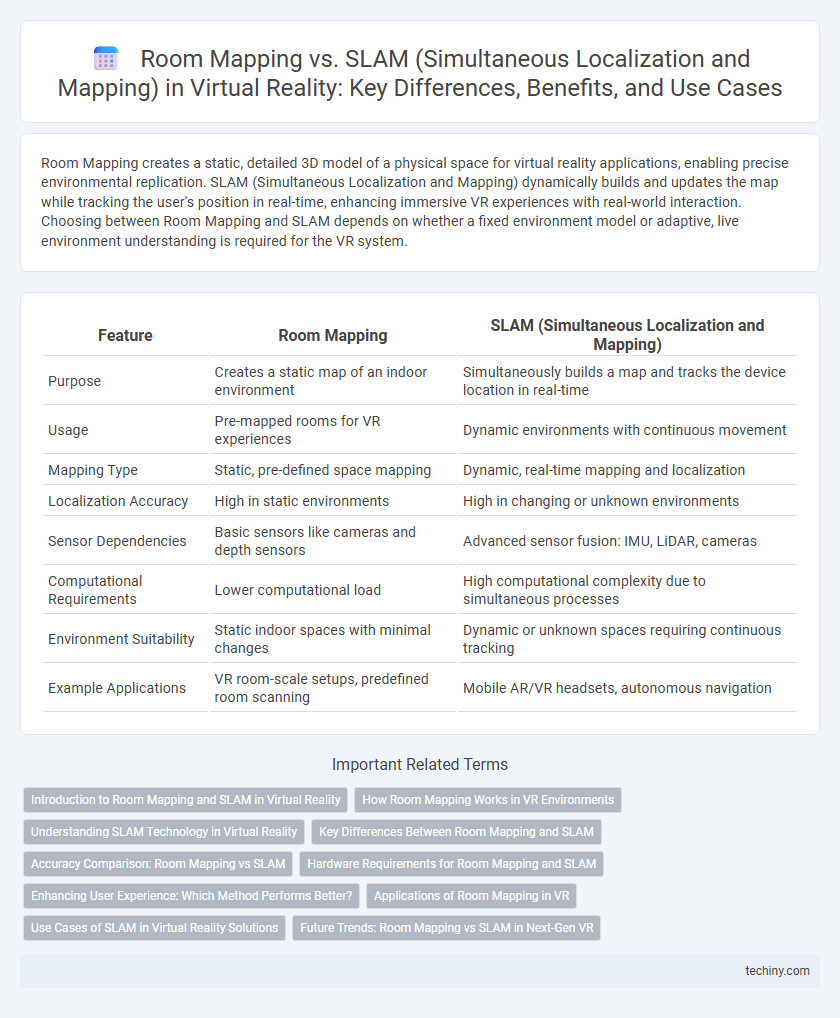Room Mapping creates a static, detailed 3D model of a physical space for virtual reality applications, enabling precise environmental replication. SLAM (Simultaneous Localization and Mapping) dynamically builds and updates the map while tracking the user's position in real-time, enhancing immersive VR experiences with real-world interaction. Choosing between Room Mapping and SLAM depends on whether a fixed environment model or adaptive, live environment understanding is required for the VR system.
Table of Comparison
| Feature | Room Mapping | SLAM (Simultaneous Localization and Mapping) |
|---|---|---|
| Purpose | Creates a static map of an indoor environment | Simultaneously builds a map and tracks the device location in real-time |
| Usage | Pre-mapped rooms for VR experiences | Dynamic environments with continuous movement |
| Mapping Type | Static, pre-defined space mapping | Dynamic, real-time mapping and localization |
| Localization Accuracy | High in static environments | High in changing or unknown environments |
| Sensor Dependencies | Basic sensors like cameras and depth sensors | Advanced sensor fusion: IMU, LiDAR, cameras |
| Computational Requirements | Lower computational load | High computational complexity due to simultaneous processes |
| Environment Suitability | Static indoor spaces with minimal changes | Dynamic or unknown spaces requiring continuous tracking |
| Example Applications | VR room-scale setups, predefined room scanning | Mobile AR/VR headsets, autonomous navigation |
Introduction to Room Mapping and SLAM in Virtual Reality
Room mapping in virtual reality involves creating accurate 3D models of an environment using pre-scanned or sensor data, enabling immersive spatial understanding and interaction. SLAM (Simultaneous Localization and Mapping) algorithms dynamically generate maps while tracking the VR device's position in real time, crucial for untethered, responsive experiences. Both technologies enhance VR navigation and interactivity by providing precise environmental awareness and spatial orientation.
How Room Mapping Works in VR Environments
Room mapping in VR environments uses depth sensors and cameras to create a detailed 3D model of the physical space, capturing geometry, surface textures, and object placement. This spatial data enables accurate boundary definitions and real-time interaction between virtual content and the user's surroundings. Unlike SLAM, which continuously updates location while mapping, room mapping often relies on predefined scans to optimize performance and immersion.
Understanding SLAM Technology in Virtual Reality
SLAM (Simultaneous Localization and Mapping) technology in virtual reality enables precise tracking by simultaneously constructing a map of the environment while estimating the user's location within that space. Unlike traditional room mapping, which requires predefined spatial data, SLAM dynamically adapts to changes and unknown environments, enhancing immersion and interaction accuracy. This real-time spatial awareness is critical for seamless movement and object placement in VR applications.
Key Differences Between Room Mapping and SLAM
Room mapping primarily involves creating a static 3D representation of an environment's layout, focusing on spatial dimensions and object placement without continuous updates. SLAM (Simultaneous Localization and Mapping) integrates real-time localization and environment mapping, allowing VR systems to dynamically track user movement while updating the map simultaneously. The key differences lie in SLAM's ability to handle dynamic environments and user motion, whereas room mapping typically produces a fixed model used for navigation or interaction.
Accuracy Comparison: Room Mapping vs SLAM
Room Mapping offers high accuracy in predefined indoor environments through detailed spatial data capture, making it ideal for VR applications requiring precise static layouts. SLAM (Simultaneous Localization and Mapping) provides dynamic real-time mapping with reasonable accuracy, adjusting to changing environments and user movement, which is essential for interactive VR experiences. While Room Mapping excels in accuracy for fixed spaces, SLAM balances accuracy with adaptability, enabling VR systems to function in unknown or evolving settings.
Hardware Requirements for Room Mapping and SLAM
Room Mapping typically relies on external sensors such as depth cameras or LiDAR to create accurate environmental models, demanding high-resolution capture devices and robust processing units. SLAM (Simultaneous Localization and Mapping) integrates sensor fusion from IMUs, RGB-D cameras, or LiDAR sensors directly mounted on the device, necessitating real-time processing capabilities and efficient onboard computing. Hardware for SLAM must balance low-latency localization with dynamic mapping, while Room Mapping systems often require stationary high-precision hardware setups for detailed spatial data acquisition.
Enhancing User Experience: Which Method Performs Better?
Room mapping and SLAM both enhance user experience in virtual reality by providing spatial awareness, yet SLAM outperforms traditional room mapping by dynamically updating maps in real-time as users move. SLAM's ability to simultaneously localize the device and map unknown environments delivers smoother, more immersive interactions without requiring pre-scanned spaces. This adaptability is critical for complex VR applications where accurate tracking and immediate environmental feedback significantly improve user immersion and navigation accuracy.
Applications of Room Mapping in VR
Room mapping in VR enables precise environmental scanning, enhancing spatial awareness and interaction by creating detailed 3D models of indoor spaces. It supports dynamic content placement, improved navigation, and realistic occlusion, crucial for immersive gaming, virtual tours, and training simulations. Unlike SLAM, which simultaneously builds maps and localizes users, room mapping specifically focuses on accurate indoor environment reconstruction to optimize VR experience fidelity.
Use Cases of SLAM in Virtual Reality Solutions
SLAM technology enables virtual reality solutions to create accurate, real-time 3D maps of indoor environments, enhancing user immersion by dynamically tracking movement and spatial changes. It supports applications such as VR gaming, where precise room mapping allows for seamless navigation, and industrial simulations, improving training accuracy through live environment interaction. Mobile VR devices and augmented reality headsets rely heavily on SLAM for efficient localization and environment awareness without requiring external sensors.
Future Trends: Room Mapping vs SLAM in Next-Gen VR
Future trends in VR emphasize the convergence of room mapping and SLAM technologies to enhance spatial awareness and immersion. Advanced SLAM algorithms combined with high-resolution room mapping enable real-time, accurate environment reconstruction, crucial for next-gen VR experiences. Integration of AI and edge computing promises more efficient and scalable room mapping solutions, reducing latency and improving user interaction fidelity in dynamic virtual spaces.
Room Mapping vs SLAM (Simultaneous Localization and Mapping) Infographic

 techiny.com
techiny.com